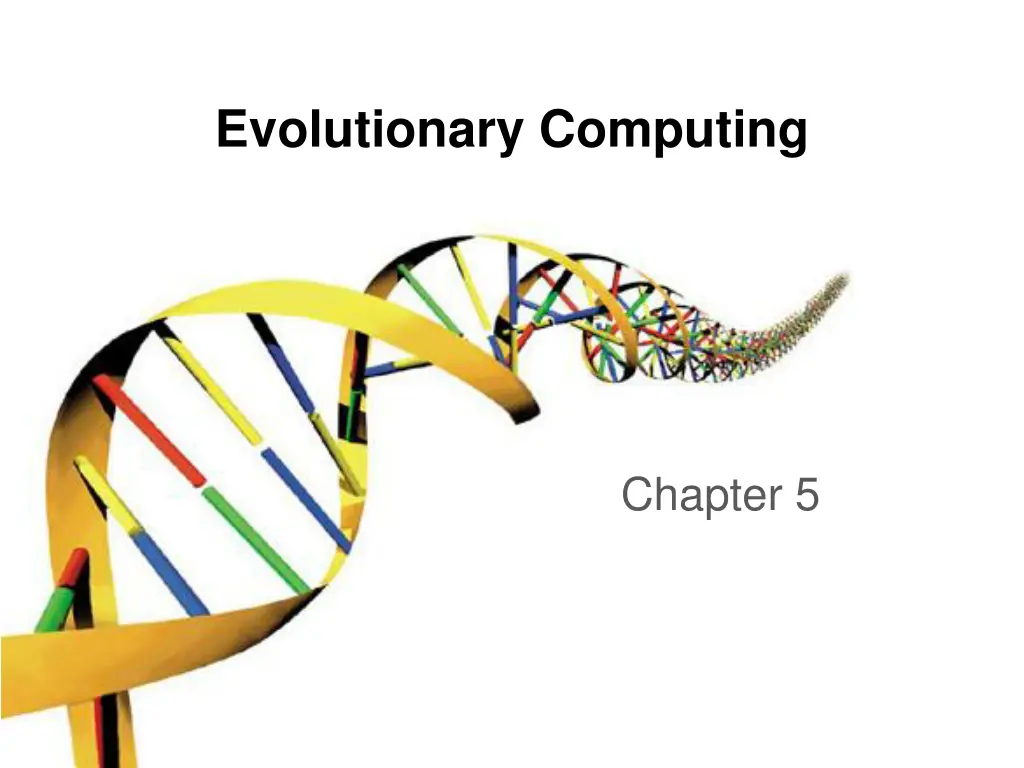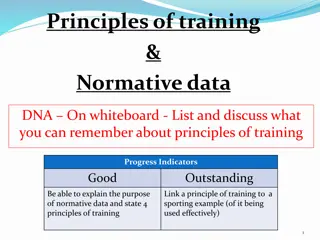
Understanding Evolutionary Computing Principles
Explore the essentials of evolutionary computing, focusing on fitness evaluation, selection mechanisms, and population management models. Learn about parent selection, population replacement strategies, and the role of diversity in evolutionary systems.
Uploaded on | 0 Views
Download Presentation

Please find below an Image/Link to download the presentation.
The content on the website is provided AS IS for your information and personal use only. It may not be sold, licensed, or shared on other websites without obtaining consent from the author. If you encounter any issues during the download, it is possible that the publisher has removed the file from their server.
You are allowed to download the files provided on this website for personal or commercial use, subject to the condition that they are used lawfully. All files are the property of their respective owners.
The content on the website is provided AS IS for your information and personal use only. It may not be sold, licensed, or shared on other websites without obtaining consent from the author.
E N D
Presentation Transcript
Evolutionary Computing Chapter 5
Chapter 5: Fitness, Selection and Population Management Selection is second fundamental force for evolutionary systems Components exist of: - Population management models - Selection operators - Preserving diversity 2 / 32
Scheme of an EA: General scheme of EAs Parent selection Parents Intialization Recombination (crossover) Population Mutation Termination Offspring Survivor selection 3 / 32
Population Management Models: Introduction Two different population management models exist: Generational model each individual survives for exactly one generation the entire set of parents is replaced by the offspring Steady-state model one offspring is generated per generation one member of population replaced Generation Gap The proportion of the population replaced Parameter = 1.0 for GGA, = 1/pop_size for SSGA 4 / 32
Population Management Models: Fitness based competition Selection can occur in two places: Selection from current generation to take part in mating (parent selection) Selection from parents + offspring to go into next generation (survivor selection) Selection operators work on whole individual i.e. they are representation-independent ! Distinction between selection Operators: define selection probabilities Algorithms: define how probabilities are implemented 5 / 32
Parent Selection: Fitness-Proportionate Selection Probability for individual i to be selected for mating in a population size with FPS is m PFPS(i)= fi fj j=1 Problems include One highly fit member can rapidly take over if rest of population is much less fit: Premature Convergence At end of runs when fitnesses are similar, loss of selection pressure Highly susceptible to function transposition (example next slide) Scaling can fix last two problems Windowing: f '(i)= f(i)-bt where is worst fitness in this (last n) generations Sigma Scaling: f '(i)=max(f(i)-(f -c sf),0) where c is a constant, usually 2.0 6 / 32
Parent Selection: Rank-based Selection Attempt to remove problems of FPS by basing selection probabilities on relative rather than absolute fitness Rank population according to fitness and then base selection probabilities on rank (fittest has rank -1 and worst rank 0) This imposes a sorting overhead on the algorithm, but this is usually negligible compared to the fitness evaluation time 7 / 32
Rank-based Selection: Linear Ranking Plin-rank(i)=(2-s) +2i(s-1) m(m-1) m Parameterised by factor s: 1 < s 2 measures advantage of best individual Simple 3 member example 8 / 32
Rank-based selection: Exponential Ranking Pexp-rank(i)=1-e-i c Linear Ranking is limited in selection pressure Exponential Ranking can allocate more than 2 copies to fittest individual Normalise constant factor c according to population size Sample mating pool from the selection probability distribution (roulette wheel, stochastic universal sampling) 9 / 32
Parent Selection: Tournament Selection (1/2) All methods above rely on global population statistics Could be a bottleneck esp. on parallel machines, very large population Relies on presence of external fitness function which might not exist: e.g. evolving game players Idea for a procedure using only local fitness information: Pick k members at random then select the best of these Repeat to select more individuals 10 / 32
Parent Selection: Tournament Selection (2/2) Probability of selecting i will depend on: Rank of i Size of sample k higher k increases selection pressure Whether contestants are picked with replacement Picking without replacement increases selection pressure Whether fittest contestant always wins (deterministic) or this happens with probability p 11 / 32
Parent Selection: Uniform Puniform(i)=1 m Parents are selected by uniform random distribution whenever an operator needs one/some Uniform parent selection is unbiased - every individual has the same probability to be selected When working with extremely large populations, over- selection can be used. 12 / 32
Survivor Selection Managing the process of reducing the working memory of the EA from a set of parents and offspring to a set of individuals forming the next generation The parent selection mechanisms can also be used for selecting survivors Survivor selection can be divided into two approaches: Age-Based Selection Fitness is not taken into account In SSGA can implement as delete-random (not recommended) or as first-in-first-out (a.k.a. delete-oldest) Fitness-Based Replacement 13 / 32
Fitness-based replacement (1/2) Elitism Always keep at least one copy of the fittest solution so far Widely used in both population models (GGA, SSGA) GENITOR: a.k.a. delete-worst From Whitley s original Steady-State algorithm (he also used linear ranking for parent selection) Rapid takeover: use with large populations or no duplicates policy Round-robin tournament P(t): parents, P (t): offspring Pairwise competitions in round-robin format: Each solution x from P(t) P (t) is evaluated against q other randomly chosen solutions For each comparison, a "win" is assigned if x is better than its opponent The solutions with the greatest number of wins are retained to be parents of the next generation Parameter q allows tuning selection pressure Typically q = 10 14 / 32
Fitness-based replacement (2/2) ( , )-selection - based on the set of children only ( > ) - choose best ( + )-selection - based on the set of parents and children - choose best Often ( , )-selection is preferred for: Better in leaving local optima Better in following moving optima Using the + strategy bad values can survive in x, too long if their host x is very fit 7 is a traditionally good setting (decreasing over the last couple of years, 3 seems more popular lately) 15 / 32
Selection Pressure Takeover time *is a measure to quantify the selection pressure The number of generations it takes until the application of selection completely fills the population with copies of the best individual Goldberg and Deb showed: lnl ln(l /m) t*= For proportional selection in a genetic algorithm the takeover time is ln( ) 16 / 32
Multimodality Most interesting problems have more than one locally optimal solution. / 32 17
Multimodality: Genetic Drift Finite population with global mixing and selection eventually convergence around one optimum Why? Often might want to identify several possible peaks Sub-optimum can be more attractive / 32 18
Approaches for Preserving Diversity: Introduction (1/2) Explicit vs implicit Implicit approaches: Impose an equivalent of geographical separation Impose an equivalent of speciation Explicit approaches Make similar individuals compete for resources (fitness) Make similar individuals compete with each other for survival 19 / 32
Approaches for Preserving Diversity: Introduction (1/2) Different spaces: Genotype space Set of representable solutions Phenotype space The end result Neighbourhood structure may bear little relation with genotype space Algorithmic space Equivalent of the geographical space on which life on earth has evolved Structuring the population of candidate solutions 20 / 32
Explicit Approaches for Preserving Diversity: Fitness Sharing (1/2) Restricts the number of individuals within a given niche by sharing their fitness, so as to allocate individuals to niches in proportion to the niche fitness need to set the size of the niche share in either genotype or phenotype space run EA as normal but after each generation set ) ( ) ( ' j i d sh f i 1-d /s d s = f i sh(d)= = j ( , ( )) 0 otherwise 1 / 32 21
Explicit Approaches for Preserving Diversity: Fitness Sharing (2/2) Note: if we used sh(d) = 1 for d < share then the sum that reduces the fitness would simply count the number of neighbours, i.e., individuals closer than share This creates an advantage of being alone in the neighbourhood Using 1 d/ share instead of 1 implies that we count distant neighbours less / 32 22
Explicit Approaches for Preserving Diversity: Crowding (1/2) Attempts to distribute individuals evenly amongst niches relies on the assumption that offspring will tend to be close to parents uses a distance metric in ph/genotype space randomly shuffle and pair parents, produce 2 offspring set up the parent vs. child tournaments such that the intertournament distances are minimal / 32 23
Explicit Approaches for Preserving Diversity: Crowding (2/2) That is, number the two p s (parents )and the two o s (offspring) such that d(p1,o1) + d(p2,o2) < d(p1,o2) + d(p2,o1) and let o1 compete with p1 and o2 compete with p2 / 32 24
Explicit Approaches for Preserving Diversity: Crowding or Fitness sharing? Observe the number of individuals per niche / 32 25
Implicit Approaches for Preserving Diversity: Automatic Speciation Either only mate with genotypically / phenotypically similar members or Add bits (tags) to problem representation that are initially randomly set subject to recombination and mutation when selecting partner for recombination, only pick members with a good match / 32 26
Implicit Approaches for Preserving Diversity: Island Model Parallel EAs (1/4) EA EA EA EA EA Periodic migration of individual solutions between populations / 32 27
Implicit Approaches for Preserving Diversity: Island Model Parallel EAs (2/4) Run multiple populations in parallel After a (usually fixed) number of generations (an Epoch), exchange individuals with neighbours Repeat until ending criteria met Partially inspired by parallel/clustered systems / 32 28
Island Model: Parameters How often to exchange individuals ? too quick and all sub-populations converge to same solution too slow and waste time most authors use range~ 25-150 generations can do it adaptively (stop each pop when no improvement for (say) 25 generations) How many, which individuals to exchange ? usually ~2-5, but depends on population size. Copied vs moved Martin et al found that better to exchange randomly selected individuals than best Operators can differ between the sub-populations / 32 29
Implicit Approaches for Preserving Diversity: Cellular EAs (1/3) Impose spatial structure (usually grid) in 1 pop Current individual Neighbours / 32 30
Implicit Approaches for Preserving Diversity: Cellular EAs (2/3) Consider each individual to exist on a point on a (usually rectangular toroid) grid Selection (hence recombination) and replacement happen using concept of a neighbourhood a.k.a. deme Leads to different parts of grid searching different parts of space, good solutions diffuse across grid over a number of gens / 32 31
Implicit Approaches for Preserving Diversity: Cellular EAs (3/3) Assume rectangular grid so each individual has 8 immediate neighbours Equivalent of 1 generation is: pick individual in pop at random pick one of its neighbours using roulette wheel crossover to produce 1 child, mutate replace individual if fitter circle through population until done 32 / 32






















